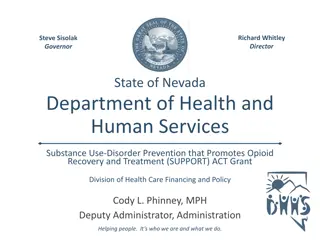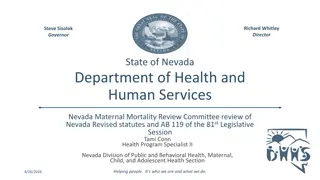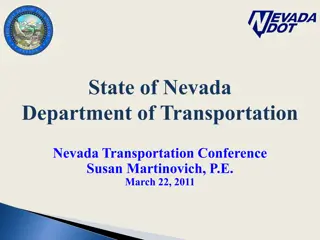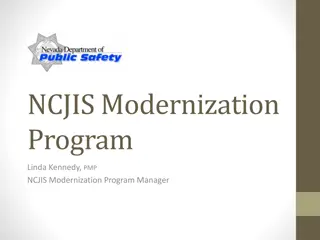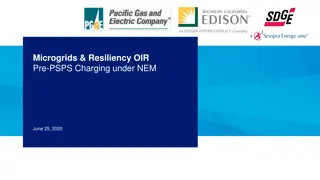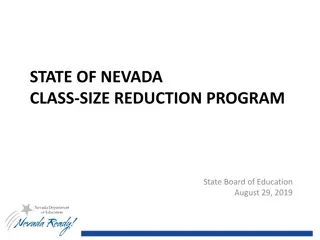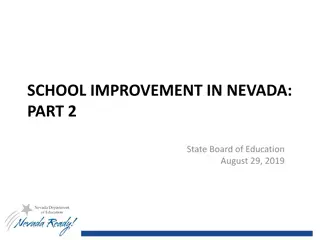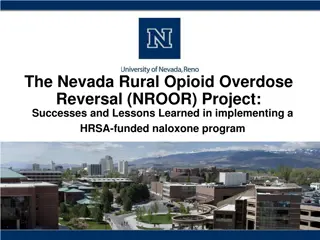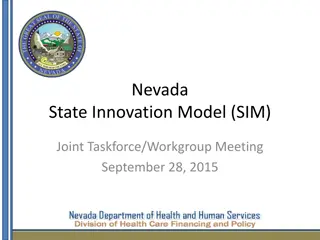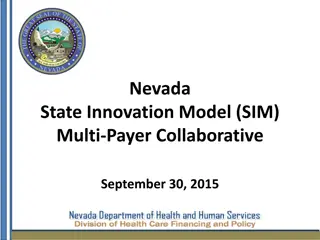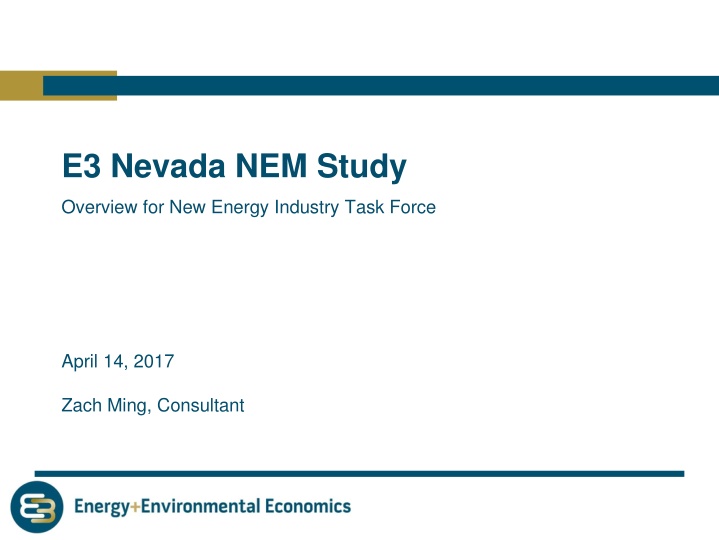
E3 Nevada NEM Study
In this study overview presented by Zach Ming, a consultant, detailed insights into Nevada's Net Energy Metering (NEM) policies and their implications for the emerging energy industry are discussed. The document comprehensively covers key aspects of the NEM program, its current status, challenges, and opportunities for stakeholders in the energy sector. Ming's analysis sheds light on the evolving landscape of renewable energy in Nevada and provides valuable information for decision-makers and industry professionals navigating this dynamic environment.
Download Presentation

Please find below an Image/Link to download the presentation.
The content on the website is provided AS IS for your information and personal use only. It may not be sold, licensed, or shared on other websites without obtaining consent from the author. If you encounter any issues during the download, it is possible that the publisher has removed the file from their server.
You are allowed to download the files provided on this website for personal or commercial use, subject to the condition that they are used lawfully. All files are the property of their respective owners.
The content on the website is provided AS IS for your information and personal use only. It may not be sold, licensed, or shared on other websites without obtaining consent from the author.
E N D
Presentation Transcript
E3 Nevada NEM Study Overview for New Energy Industry Task Force April 14, 2017 Zach Ming, Consultant
About E3 Founded in 1989, E3 operates at the nexus of Energy Environment Economics 40 professional staff located in San Francisco, CA composed of Economists Engineers Resource planners Public policy experts E3 staff bring a deep understanding of analytical techniques and electricity industry economics to solve high-level problems for a wide variety of clients State Agencies Regulatory Authorities State Executive Branches Legislators Utilities System Operators Financial Institutions Consumer Advocates Environmental Interests Energy Consumers Project Developers Emerging Technology Companies 1
Nevada NEM Study Overview E3 commissioned by PUCN in 2014 to forecast the costs and benefits of NEM in Nevada in response to Nevada AB 428 Study completed under direction of PUCN with regular input throughout the process from a stakeholder advisory group including PUCN staff Utility Solar industry Ratepayer advocates Study completed using publically available data where possible with a publically available analysis tool (some confidential utility data redacted) Funded by the National Association of Regulatory Commissioners (NARUC) and many others 2
Key Study Questions Costs and benefits of NEM in Nevada calculated from five perspectives using an industry standard approach Participant + Bill credits & subsidies - Installation cost = Cost-effectiveness Is NEM cost-effective for the customers who install systems? Non-Participating Ratepayer + Utility avoided costs - Bill credits & subsidies = Cost-effectiveness Does NEM raise or lower rates for other customers? Program Administrator (Utility) + Utility avoided costs - Integration and program costs = Cost-effectiveness Does total bill revenue collected increase or decrease? State of Nevada + Utility avoided costs - Installation cost = Cost-effectiveness Is NEM a cost-effective resource for Nevada? Is NEM a cost-effective resource when including societal benefits? Society + Utility avoided costs & societal benefits - Installation cost = Cost-effectiveness 3
Ratepayer Impact Measure (the RIM test) NEM provides value to the utility by reducing energy purchases, new power plant purchases, etc these are known as avoided costs If the bill savings to NEM customers exceed avoided costs, there is a cost- shift that raises rates to non-participating customers 4
Input Assumptions and Major Sources Results are driven by study assumptions Used resource plans developed at the PUCN in 2012 and 2013 NV Energy provided utility avoided cost data A number of factors have since changed which would impacts study results Senate Bill 123 Coal retirements New build of both renewable and conventional generation Market developments Natural gas price decline Solar price decline 5
Ratepayer Impact Measure Results Base Case $0.35 E3 separated NEM customers into three vintage categories Levelized Cost-Benefit ($/kWh) $0.30 1) Installations through 2013 Policy and incentives in 2013 $0.25 $0.20 1) 2014/2015 vintage Incentives reduced in 2014 $0.15 $0.10 1) 2016 vintage RPS multiplier reduced in 2016 $0.05 $0.00 Cost Benefit Cost Benefit Cost Benefit Cost Benefit E3 forecasts a cost-shift for existing systems, but a net benefit to ratepayers for systems installed after 2014 All Vintages Existing Installations (through 2013) 2014/2015 Installations 2016 Installations Integration Costs RPS Value Utility Avoided Costs NEM Program Costs Utility Incentives NEM Customer Bill Savings 6
RPS Value $0.35 Levelized Cost-Benefit ($/kWh) $0.30 Incentivized NEM generation counts towards RPS in NV For systems built before 2016, every MWh of generation counts as 2.45 RPS credits NEM also reduces the RPS compliance obligation by reducing net load (obligation: 25% of all generation by 2025) Result: 1 MWh of NEM PV generation in 2015 can be banked until 2020, when it can replace almost 2.7 MWh (2.45 + 0.25) of utility-scale PV generation Note: this value only applies in future years when NV Energy needs to procure renewable energy for compliance (> 2020) SB 123 could change these results $0.25 $0.20 $0.15 $0.10 $0.05 $0.00 Cost Benefit Cost Benefit Cost Benefit Cost Benefit All Vintages Existing Installations (through 2013) 2014/2015 Installations 2016 Installations Integration Costs RPS Value Utility Avoided Costs NEM Program Costs Utility Incentives NEM Customer Bill Savings 7
Participant Cost Test Results Base Case $0.50 $0.45 Levelized Cost-Benefit ($/kWh) $0.40 Installing a NEM system was historically beneficial to the average participant $0.35 $0.30 $0.25 $0.20 $0.15 Based on solar cost forecasts at the time of the study, NEM is not cost-effective for participants in 2014 and beyond $0.10 $0.05 $0.00 Cost Benefit Cost Benefit Cost Benefit Cost Benefit All Vintages Existing Installations (through 2013) 2014/2015 Installations 2016 Installations Federal Incentives NEM Customer Bill Savings Utility Incentives Pre-Incentive Capital Cost 8
Total Resource (Nevada) Cost Test Base Case $0.50 Levelized Cost-Benefit ($/kWh) Overall, NEM installed through 2016 will cost NV about $100 million or $0.02/kWh $0.45 $0.40 $0.35 $0.30 $0.25 With the RPS multiplier, 2014/2015 NEM installations save NV money $0.20 $0.15 $0.10 $0.05 Note - adding emissions related externalities adds more costs because NEM reduces total installed renewable capacity $0.00 Cost Benefit Cost Benefit Cost Benefit Cost Benefit All Vintages Existing Installations (through 2013) 2014/2015 Installations 2016 Installations Pre-Incentive Capital Cost Federal Incentives NEM Program Costs Utility Avoided Costs RPS Value Integration Costs 9
Sensitivity Results - Utility-Scale Solar Price The cost of utility-scale solar impacts the cost-effectiveness of NEM significantly since NEM avoids purchases of additional utility-scale solar $1200 MM Actual publicly released costs of utility scale solar are less than $50/MWh for utility scale solar NPV Net Benefit $800 MM $400 MM $0 MM -$400 MM -$800 MM Based on these contracts, the Low PPA price sensitivity is more appropriate than the base case assumption Ratepayer Impact Measure Program Administrator (Utility) Cost Test Total Resource Cost Test Societal Cost Test Low PPA Price Base Case PPA Price High PPA Price 10
What Has Changed Since the Study? Many changes have occurred since the study We don t currently know the magnitude of each change or the net impact of all changes combined Nevada/Societal Perspective Perspective Ratepayer benefits increase relative to costs costs increase relative to benefits n/a New NEM tariffs SB 123: 800 MW of coal retirements SB 123: 350 MW of additional renewable capacity (+200 MW conventional) Continued dramatic decreases in cost of solar (utility-scale and NEM) Decrease in natural gas prices Other utility resource planning changes n/a ? ? 11
Contact Information For more information contact: Zach Ming zachary.ming@ethree.com Energy and Environmental Economics, Inc. (E3) 101 Montgomery Street, Suite 1600 San Francisco, CA 94104 (415) 391-5100 www.ethree.com 12
NEM PV Forecast 14 14
NV NEM Subsidies 15 15
Detailed Base Case Results Participants Benefit (cost) to customers who participate in NEM Installs through 2013 All installs through 2016 Installs in 2014-2015 Installs in 2016 Nevada Lifecycle NPV ($Million 2014) $23 ($115) ($43) ($135) Benefit (cost) to the state of Nevada, including externalities Installs through 2013 All installs through 2016 Installs in 2014-2015 Installs in 2016 Levelized ($2014/kWh) $0.02 ($0.03) ($0.04) ($0.02) Lifecycle NPV ($Million 2014) ($133) $90 ($36) ($75) Ratepayers Levelized ($2014/kWh) Benefit (cost) to non-participating ratepayers Installs through 2013 All installs through 2016 ($0.11) $0.02 ($0.02) ($0.01) Installs in 2014-2015 Installs in 2016 Lifecycle NPV ($Million 2014) ($141) $168 $6 $36 Levelized ($2014/kWh) ($0.14) $0.05 $0.01 $0.01 16
Distribution Sensitivity $1000 MM NPV Net Benefit $800 MM $600 MM $400 MM $200 MM $0 MM -$200 MM Ratepayer Impact Measure Program Administrator (Utility) Cost Test Total Resource Cost Test Societal Cost Test Base Case Distribution Sensitivity 17
Rate Scenario Sensitivity $150 MM $100 MM NPV Net Benefit $50 MM $0 MM -$50 MM -$100 MM -$150 MM -$200 MM -$250 MM Participant Cost Test Ratepayer Impact Measure Current Rate Scenario Rule 9 Compliance + Primary 18
Rate Escalation Sensitivity $100 MM NPV Net Benefits $50 MM $0 MM -$50 MM -$100 MM -$150 MM -$200 MM Participant Cost Test Ratepayer Impact Measure Low Rate Escalation Base Case Rate Escalation High Rate Escalation 19
Demand Charge Sensitivity $80 MM $40 MM NPV Net Benefit $0 MM -$40 MM -$80 MM -$120 MM -$160 MM Participant Cost Test Ratepayer Impact Measure Base Case Demand Charge Sensitivity 20
Utility-Scale PPS Sensitivity $1200 MM NPV Net Benefit $800 MM $400 MM $0 MM -$400 MM -$800 MM Ratepayer Impact Measure Program Administrator (Utility) Cost Test Total Resource Cost Test Societal Cost Test Low PPA Price Base Case PPA Price High PPA Price 21




